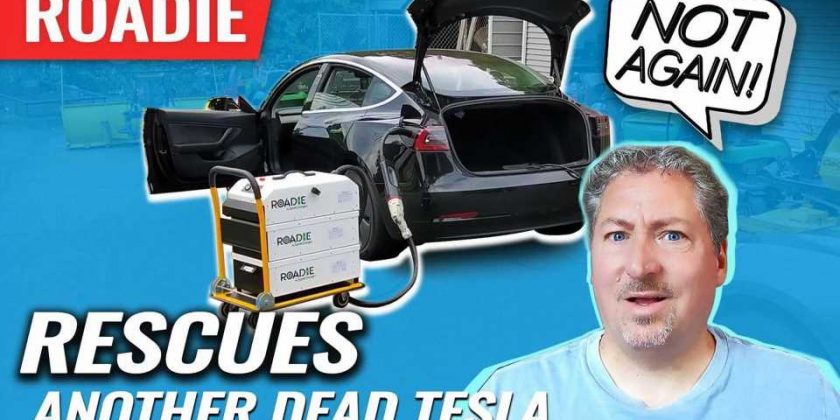The Roadie saves the day again.
The SparkCharge Roadie mobile DC fast charge system saved another Tesla Model 3 driver that ran out of charge before reaching their destination. If this sounds familiar, that’s because a few weeks ago we posted a video of a similar situation in which another person that had rented Model 3 ran out of juice before reaching the Supercharger, and left the vehicle abandoned in a parking lot.
We have a SparkCharge Roadie system on a long-term loan to use for a variety of tests and videos, but we didn’t get it so we could become a local roadside assistance provider. Be that as it may, this is the second time we’ve been asked to use it for just that, because a local EV rental company that we’ve rented cars from in the past, has asked us to help them out.
The stranded Tesla Model 3 charging up from the SparkCharge Roadie DC fast charge system:
The last time we were called to action, we only plugged in and charged the vehicle for a few minutes, because the car was very close to the Supercharger when it ran out. Therefore, I didn’t record the charging information displayed on the Model 3’s infotainment screen, and we had a few people comment asking why I didn’t do so.
So when we received another call for help, we figured it would be worth the short trip to help out the stranded motorist, and we could also get the recordings that we didn’t capture on the last rescue mission.
The Roadie is a modular DC fast charge system that stacks one to four battery modules on top of each other. The charging unit then connects to the top of the battery module(s).
Each battery module has a total capacity of 3.7 kWh and a usable capacity of 3.5 kWh. A four-battery system can deliver a total of up to 14 kWh. The Roadie system is available with either a CCS1 or CHAdeMO connector and can deliver up to 20 kW to the vehicle. When it’s charging at the full rate, that’s good enough to charge at a rate of nearly a mile a minute.
However, I didn’t get the Roadie to charge at its maximum 20 kW charge rate. The system was delivering 8 kW when I initially plugged in, but quickly rost to 13 kW and held that charge rate for the rest of the charging session. It’s still not entirely clear why the system peaked at 13 kW but we suspect it was due to the Model 3’s pack voltage. We’ll use the system on a Model 3 that has a higher state of charge soon to see if the higher pack voltage increases the charge rate.
It took us 25 minutes to deplete the batteries (they weren’t already fully charged since I wasn’t expecting to do this roadside rescue) and it added 18 miles of range to the Model 3. That was plenty to get the car to the closest Tesla Supercharger site as it was only 12 miles away.
There’s definitely a need for mobile DC fast charging, and we believe the Roadie can be an effective tool for a variety of different uses. There are some improvements that Sparkcharge can make to the system that we’d like to see, including a way to know the system’s state of charge and even faster charging. SparkCharge has been improving the Roadie since it was first introduced, so we have no reason to believe they won’t continue to make improvements as they see the need to do so.
So check out the video and let us know what you think. What features would you add to make the Roadie system better?
Source:State Of Charge (YouTube)
Source: Read Full Article

